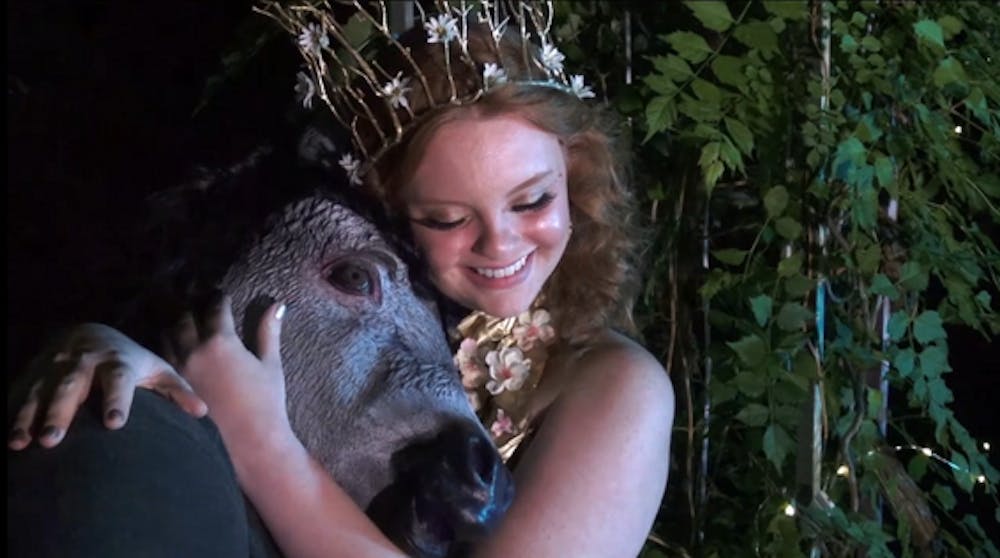Last week the University of New Hampshire’s Theatre and Dance department released a filmed production of Shakespeare’s classic comedy “A Midsummer Night’s Dream” directed by Deb Kinghorn. This supernatural play of confused lovers, feuding fairies, and overly eager thespians marks a deviation from the department’s general approach to theatre. As a result of COVID-19 and the limitations it has put on theatre, the production took a note from the Bard himself and made the world their stage - or at least, the university’s campus. Utilizing on-site locations such as the elaborate ballroom of Hubbard Hall, a spacious woodshop and, most notably, College Woods, this is only one way that the production adapted to these strange times. Forgoing the standard way most staged theatre is filmed, the production leaned into its new medium and all of the cinematography that comes with it, dynamic angles and all.
When digitally working with film, it can be tempting to implement a wide range of special effects, especially when working with the fantastical. However in the world of theatre, both live and filmed, subtly often is the production’s best friend. An overproduced show can look messy or flashy enough that the effects break the audience’s suspension of disbelief, a risk that is even greater when audiences are not present physically. Suffice to say, UNH’s “A Midsummer Night’s Dream” did not commit this error in the slightest. In fact, the ways in which the production utilized special effects only helped make the show all the more immersive for the viewer, such as when the fairies used their magic to snap themselves (and the occasional mortal head) in and out of sight. Not only did moments like these help make the production feel all the more magical, but coupled with cleverly-placed music, cinematographic gems in the show only managed to shine brighter in the production.
Amidst the exceptional technical aspects of the production, the cast itself cannot be overlooked. Each performer’s delivery managed to capture the lyricism of Shakespeare’s writing while conveying enough passion and humor in their performances that modern audiences can effortlessly follow along. The intimacy between the lovers Lysander and Hermia (played by Galen Graham and Emma White) before their romance is interrupted by magical mischief is played with such sweet tenderness that even with a happy ending guaranteed, Lysander’s spellbound rejection of Hermia manages to tug at the heartstrings. In a similar vein, Julia Sommer’s portrayal of Helena itself is at times comical but almost tragic as her performance manages to capture the frustration and distrustfulness of one scorned by unrequited love one too many times by the suave and brooding Demetrius played by Joe Salari. Veering away from the lovers, the rulers of the fairy court itself manage to be a powerhouse in this production as well. Jordan Quinn and Alex Natario as Titania and Oberon bring an almost fearsome intensity to their roles that when balanced with their comedy shows their skillful range as actors. The iconic role of Robin Goodfellow, better known as Puck, played by Abby Kaye is also well-done as each line is delivered dripping with devilish mischief. Last but certainly not least, Zeke Solis’ portrayal of Nick Bottom, Shakespeare’s famous donkey-domed thespian, is packed to the brim with energy and charisma in every scene, especially when in scenes with the cheerful-but-exasperated Quince (played by Olivia Fonseca) who has to endure his ego.
Another highlight of this particular production is the balance between contemporary costuming and devices such as cellphones and the fantastical design of the fairy world. Initially, characters decked in modern dress seems like an odd choice, but when contrasted with the elaborate and dazzling costuming of the fairy queen and the rest of the court, it strengthens the fact that these wandering mortals are entering another world. With that, the inclusion of contemporary elements such as using phones for light never feel intrusive in the performance or notably anachronistic.
If there were any doubts regarding how theatre can maintain its quality when stripped of live audiences and standard staging, the theatre and dance department’s production of “A Midsummer Night’s Dream” puts them to rest. The effort of the cast, director, stage crew, and everyone involved in the production is well-apparent and has paid off tremendously. The concept of treating production as a film was a worthy experiment that yielded impressive results in regard to quality. As the university continues to explore performing productions like this in the near future in spite of the pandemic, I for one eagerly wait to be an audience member and see what directions the theatre department goes.
Photo Courtesy of the UNH Theatre Department














